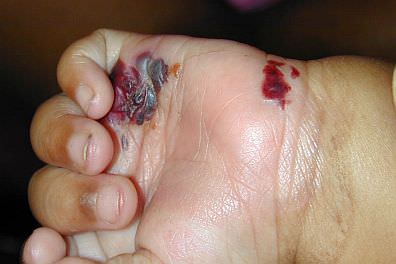Contact Us
 Epidermolysis bullosa (EB) is a rare genetic disease characterized by the presence of extremely fragile skin and recurrent blister formation, resulting from minor mechanical friction or trauma. This condition is not contagious.
Epidermolysis bullosa (EB) is a rare genetic disease characterized by the presence of extremely fragile skin and recurrent blister formation, resulting from minor mechanical friction or trauma. This condition is not contagious.
In severe EB, blisters are not confined to the outer skin. They may develop on the soft tissues (mucous membranes) inside the body such as the linings of the mouth, esophagus, stomach, intestines, lungs, bladder and genitals. The extent of tissue involvement experienced by an individual is usually determined by the severity of the disease and the subtype present.
There are three main forms of inherited EB and the different subtypes are defined by the depth of blister location within the skin layers.
Blister formation of EB simplex is within the epidermis. Sometimes EB simplex is called epidermolytic.
Blister formation in Junctional EB is seen at the level of the lamina lucida within the basement membrane zone.
Dystrophic EB or dermolytic EB is a scarring form of EB which occurs in the deeper tissue at the level of the lamina densa or upper dermis.
Autosomal Dominant Inheritance: An autosomal dominant disorder is one in which one gene for the condition expresses itself in an individual. A parent with an autosomal dominant form of EB has a 50:50 chance with each pregnancy of transmitting the abnormal gene. The chance is the same whether the child is a boy or a girl, and birth order does not make a difference. A child who does not inherit the gene for EB from an affected parent will not have the condition and cannot pass it on. In some instances, neither parent has EB, but the couple has a child with an autosomal dominant form of EB. In this situation, the condition has usually been caused by a change, or mutation in the genetic material of the egg or the sperm. When a new mutation occurs, the affected individual will have a 50:50 risk of passing the gene on in his/her pregnancies, but his/her parents will not. They have no increased risk of having a child with EB in subsequent pregnancies.
Autosomal Recessive Inheritance: An autosomal recessive disorder is one in which a recessive (unexpressed) gene for the disorder is passed from each parent and the two genes are paired together, causing the disorder to be expressed in the child. If a person has one recessive EB gene paired with a normal gene, the person is "a carrier", but does not have the disorder. If parents are each carriers of an autosomal recessive gene, there is a 25 percent chance with each pregnancy that their children will have the disorder. Again, the sex of the child and the birth order do not matter. An individual with a recessive form of EB will be at risk of having an affected child only if he or she has a child with a carrier or another person with recessive EB.
In order to appropriately identify the depth of blister location in the skin, a skin biopsy must be taken by a dermatologist. This procedure includes numbing an area and taking a small sample of skin (~4mm) for examination under a microscope.
Because EB involves many systems of the body, parents and health professionals must take a team approach to the treatment of an EB patient. Intense and total patient care often must be provided, particularly for young children. The severe forms of EB require meticulous nursing care which is similar to that given to burn patients. Much of this care is often provided by the parents; however, the education of all people who have contact with the patient is essential, including the primary care physician, the dermatologist, the nurse, the pediatric dentist, the specialist in gastrointestinal (digestive) diseases, the dietitian or nutritionist, the plastic surgeon, the psychologist or social worker, and the genetic counselor, as well as teachers, relatives, baby sitters, and others.
Although there is no cure for EB, many complications can be lessened or avoided through early intervention. In all cases, treatment of EB is directed towards the symptoms and is largely supportive. This care should focus on prevention of infection, protection of the skin against trauma, attention to nutritional deficiencies and dietary complications, minimization of deformities and contractures, and the need for psychological support for the entire family. Many persons with milder forms have minimal symptoms and may require little or no treatment.